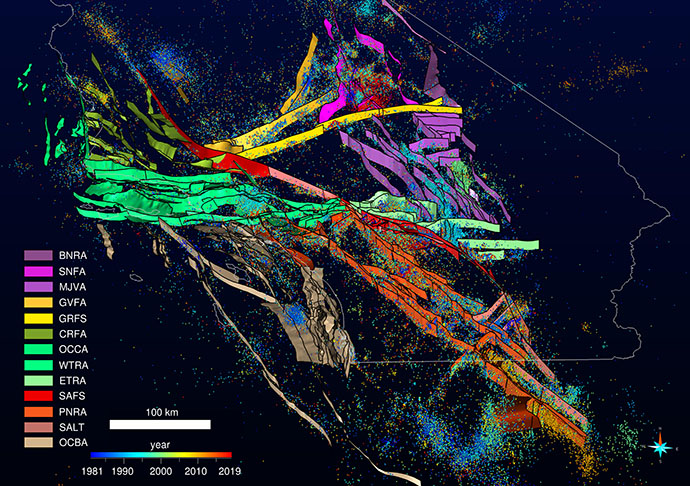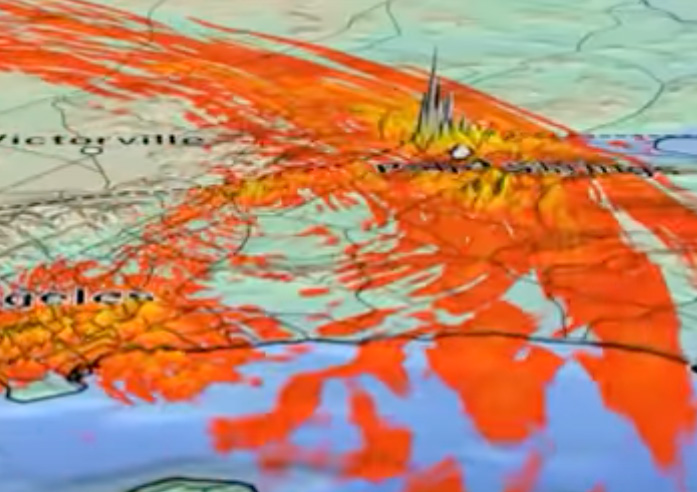Understanding the dynamics of earthquakes and faulting, and the associated geohazards, requires a systems-level approach.
The Statewide California Earthquake Center (SCEC) collaborates with academic, government, industry, and other organizations to advance earthquake science, community resilience, and education by: (1) Gathering and analyzing data from field observations and laboratory experiments. (2) Developing system-level models and simulations of earthquake processes to synthesize knowledge as a physics-based understanding of seismic hazard. (3) Communicating that understanding to expand knowledge and reduce earthquake risk.

Building Community Earth Models (CEM) for California
SCEC CEMs are collaborative platforms that provide community-contributed data, models, and tools to study key geophysical features of the San Andreas Fault System.

Developing Advanced Modeling Frameworks
SCEC develops physics-based models and advanced modeling frameworks to simulate earthquake processes and the evolution of faults and earthquakes more realistically.

Increasing California’s Resilience to Earthquakes
SCEC provides the scientific foundation for earthquake risk-reduction by integrating observations within a system science modeling framework to quantify seismic hazard.

Using Artificial Intelligence in Earthquake Science
By applying AI methods across earthquake science, SCEC is exploring its potential in fault mapping, ground motion simulations, earthquake forecasting, and more.
Each year, SCEC solicits proposals for research, workshops, and trainings through a competitive process, typically attracting hundreds of investigators to contribute to the Center’s programs. The 2024 Science Plan emphasized new opportunities enabled by a geographic scope that now includes the entire transform plate boundary system of California. It also provides a roadmap on how to distribute research efforts in southern, central, and northern California to achieve the Center’s science goals.
SCEC Research Highlights
Co-Director and SSC Chair Greg Beroza (Stanford) and PRC Chair Alice Gabriel (UCSD) present research highlights from the Statewide California Earthquake Center at 2025 SCEC Annual Meeting.
SCEC Workshop: Quakeworx Kickoff: Advancing Earthquake Science & Cybertraining in Seismology
January 21-24, 2025
SCEC Workshop: Community Stress Drop Validation Study
February 25, 2025
SCEC Workshop: Multi-Scale Seismic Velocity Models for the SAFS
April 4, 2025
SCEC Workshop: Earthquakes and Related Hazards in the Santa Barbara-Ventura Area
June 29-30, 2025
SCEC prioritizes investigator-driven, interdisciplinary research, fostering connections with scientific, engineering, and community stakeholders. This collaborative approach sustains basic and applied earthquake science research, enabling exploration of new avenues, welcoming new investigators, and providing a global platform for multidisciplinary research, workforce development, and community engagement. SCEC fosters an inclusive and diverse professional culture that maximizes the contributions of future earthquake scientists.
SCEC’s Science Steering Branch guides research by identifying promising new research directions, and engaging the broader scientific community. A Science Steering Committee sets annual science goals and solicits proposals aligned with them. A Proposal Review Committee evaluates these proposals and recommends the portfolio of projects to the Directors and Board for annual funding.
Science Steering Committee (SSC)
Monitors research progress, identifies priorities, and sets Center science goals. With input from the SCEC community and leadership, they cultivate new research ideas, and develop the annual science plan guiding proposal submissions to SCEC’s research program.
VIEW CHARTER
Proposal Review Committee (PRC)
24-30 expert reviewers (representing 12 disciplinary and interdisciplinary focus areas) who evaluate proposals submitted to SCEC, and recommend the annual portfolio of research proposals, trainings, and workshops to fund to the Board, Center Directors, and sponsors to act on.
VIEW CHARTER
The SCEC Community may register any recently published journal article, book, chapter, presentation, and more in the SCEC Publications Database. These publications may be results partially or entirely funded by SCEC.
Deterministic Physics-Based Earthquake Sequence Simulators Match Empirical Ground-Motion Models and Enable Extrapolation to Data-Poor Regimes: Application to Multifault Multimechanism Ruptures Shaw, B., Milner, K., & Goulet, C. (2025)
We use the deterministic earthquake simulator RSQSim to generate complex sequences of ruptures on fault systems used for hazard assessment. We show that the source motions combined with…
Assimilation of Deterministic Multicycle Earthquake Simulations into Probabilistic Rupture Forecasts
Luis Vazquez, & Thomas H. Jordan (2025)
A problem of growing importance in earthquake forecasting is how to compare probabilistic forecasting models with deterministic physical simulations and extract physical insights from their differences. Here we compare the time-independent Uniform California Earthquake Rupture Forecast Version 3 with a long earthquake catalog…
Variable vertical land motion and its impacts on sea level rise projections
Govorcin, M., Bekaert, D., Hamlington, B. D., et al. (2025)
Coastal vertical land motion (VLM), including uplift and subsidence, can greatly alter relative sea level projections and flood mitigations plans. Yet, current projection frameworks, such as the IPCC Sixth Assessment Report, often underestimate VLM by relying on regional linear estimates.
The SCEC/USGS Community Stress Drop Validation Study Using the 2019 Ridgecrest Earthquake Sequence
Baltay, A. S., Abercrombie, R. E., Chu, S., & Taira, T. (2024).
We introduce a community stress drop validation study using the 2019 Ridgecrest, California, earthquake sequence, in which researchers are invited to use a common dataset to independently estimate comparable measurements using…
Evidence for faulting and fluid-driven earthquake processes from seismic attenuation variations beneath metropolitan Los Angeles
Chiara Nardoni, & Patricia Persaud (2024)
Seismicity in the Los Angeles metropolitan area has been primarily attributed to the regional stress loading. Below the urban areas, earthquake sequences have occurred over time showing migration off the faults and providing evidence that secondary processes…
The USGS 2023 Conterminous U.S. Time‐Independent Earthquake Rupture Forecast
Field, E. H., Milner, K. R., Hatem, A., Powers, P. M., Pollitz, et al. (2023).
We present the 2023 U.S. Geological Survey time‐independent earthquake rupture forecast for the conterminous United States, which gives authoritative estimates of the magnitude, location, and…
Subregional Anelastic Attenuation Model for California
Buckreis, T. E., Stewart, J. P., Brandenberg, S. J., & Wang, P. (2023).
Ground‐motion models (GMMs) typically include a source‐to‐site path model that describes the attenuation of ground motion with distance due to geometric spreading and anelastic attenuation. In contemporary GMMs, the anelastic component is typically derived…
The 2023 US 50-State National Seismic Hazard Model: Overview and implications
Petersen, M. D., Shumway, A. M., Powers, P. M., Field, E. H., et al. (2023)
The US National Seismic Hazard Model (NSHM) was updated in 2023 for all 50 states using new science on seismicity, fault ruptures, ground motions, and probabilistic techniques to produce a standard of practice for public policy and other engineering applications…
The SCEC Annual Meeting brings together 400-500 participants worldwide to share breakthroughs, assess progress, and chart a collaborative path for earthquake science. All of the Center activities are presented, analyzed, and woven into a set of priorities for SCEC to pursue in the future.
Documents published by the SCEC community, including journal articles, books, chapters, presentations, etc. are collected in the SCEC publications database. Each record is identified by its SCEC Contribution Number, that can be used to acknowledgement of SCEC funding support.